- Matthew Spencer
- Albums and Singles
 Invention happens when an artist uses the tools at hand to create something novel, whatever those tools may be. This thought is particularly relevant in considering how to use a 300 year old church organ for a new piece of music. Whatever inspired its first listeners, whatever tastes they possessed, have long since expired. On Fantasma di Perarolo, Burial Hex employs that sense of dusty, half forgotten ambiance as a catalyst, using the instrument’s antiquity as a concrete element in the recording.
Invention happens when an artist uses the tools at hand to create something novel, whatever those tools may be. This thought is particularly relevant in considering how to use a 300 year old church organ for a new piece of music. Whatever inspired its first listeners, whatever tastes they possessed, have long since expired. On Fantasma di Perarolo, Burial Hex employs that sense of dusty, half forgotten ambiance as a catalyst, using the instrument’s antiquity as a concrete element in the recording.
Burial Hex is the extended keyboard and noise meditations of Clay Ruby. Since beginning the project a few years ago, Ruby has maintained a furious release schedule. As is common, Ruby uses limited edition tapes and CDRs to develop material and play with ideas in an inexpensive, flexible, and low-profile manner.What’s unique about Fantasma di Perarolo is Ruby’s supple use of atmosphere and dynamics. A lesser artist would be proud to see this widely released.
The tape consists of one long improvised piece performed at a church in Perarolo di Cadore, a tiny village high in the Italian Alps.The church organ, built between 1765 and 1768, needed to be hand pumped by two men. The back story would be superfluous were it not for the uncanny atmosphere created by Ruby and his collaborators, adding electronic tones, environmental noises, and the occasional clanging bell. The accompaniment is sparse, as if it were emanations from the building itself.
Ruby uses the wide range of dynamic options built into the organ. Hand pumping will naturally produce a subtle wavering effect in an instrument’s tone, and Ruby uses this to bring diversity to the drones that he plays.He does not, however, limit himself to simply holding down chords, but employs everything from simple minor key melodies to dense, atonal note clusters. Given the impromptu nature of the performance, lulls and sour spots inevitably occur. Fortunately, Ruby knows when to move on and when to let a particular theme or sound configuration sink in. Fantasma di Perarolo has an aged immensity to it, as if each surging chord from the organ were the encrusted layers of history falling from the walls of the church. The piece is Gothic, in the sense that it sounds medieval, like some plague-time field recording of the 14th century.
Ruby isn’t first artist to repurpose a church organ. Recent examples include Soriah and Nils Henrick Asheim. Let there be more of that. As musicians continue to explore sound based composition, the unique properties of antique and rare instruments should not be overlooked. Every church organ is different, built to suit the acoustics of its home and the tastes of the congregation. This approach meshes well with current trends of tone fetishism, cultural atavism, and environmentally determined composition. It is a difficult, at times grating album, but also one that often exudes a dark grandeur.
Read More
- Administrator
- Albums and Singles
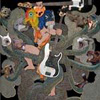 With their dual bass and drum lineup (in addition to samples and other electronic elements), Comparative Anatomy may sound like peers of Lightning Bolt, but their approach is very different. Rather than their scum-rock inclinations, CA are more adherents to the absurdist, bordering on batshit insanely comic school of rock. This is an album where each song has a different mammal as a guest "vocalist."
With their dual bass and drum lineup (in addition to samples and other electronic elements), Comparative Anatomy may sound like peers of Lightning Bolt, but their approach is very different. Rather than their scum-rock inclinations, CA are more adherents to the absurdist, bordering on batshit insanely comic school of rock. This is an album where each song has a different mammal as a guest "vocalist."
The earlier pieces are fond of the cut-and-paste random genre abuse akin to Mr. Bungle and the like."Peter Rabbit The Great's Carrot Phalanx" starts with horn notes and Casio marching band beats that eventually cut into more conventional drums and grimy synth.The track then alternates from faux strings-led drama into headbanging fodder."Swarm of Camels" does the same thing, mixing sampled non-animal vocals and heavy bass guitar riffs, and even some cellphone ring tones right out of 1999.
The heavily distorted nasal bass assaults and stiff, machine gun drums become a recurring theme, touching every track on the album, for better or worse."Elephantality" contrasts this with different rhythms and elephant samples used more as instruments than sound effects, and a healthy dose of Mortal Kombat sound effects.In "A Car Full of Seals in the Mall on the Day After Thanksgiving," the bass and drums are paired with a bit of chintzy keyboard demo sounds and cartoon music.
My biggest issue is that this formula becomes same-y after awhile.The thin bass guitar and monotone drum sounds appear throughout the album in relatively the same form, on pretty much every track."Puppy Hatred," for example, has sparser beats and undistorted bass passages that are a welcome change, but it's not utilized enough within the track.In other cases, however, it's not as glaring of a problem:"Flipper, Summoner of Storms" has a slightly different structure, and with the steady, danceable beat and dolphin noises, the results are more enjoyable and feel less stagnant.It's not a matter of all the songs sounding alike, but the similarity becomes noticeable pretty quickly
The other dancefloor smash, "Hippo Plus Model on the Runway," is complete truth in advertising when it comes to the title.Panned hippo "vocals" and what sounds like Tyra Banks samples somehow make a good pairing with the rhythms, and the grinding guitar tops it off nicely.Unlike the other songs leading up to this one, it relies less on the genre hopping jump-cuts and stands strong on its own.
Considering this is their debut release, the few missteps here are a bit easier to overlook.It’s a pet peeve of mine when a guitar or drums or whatever instrument sound so similar from track to track, and that is an issue here.Too often the same sounding pastiches appear that are almost identical to their presence the track before.Similarly, the cut-and-paste genre-hopping shtick is mostly centered on the earlier half of the disc, so it feels less like a crutch or gimmick than it would if every track did the same thing.It’s not a groundbreaking album, but one that is fun enough in its inherent goofiness.
samples:
 
Read More
- Administrator
- Albums and Singles
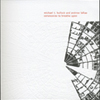 Recorded live amongst the very definition of urban decay, this duo of contrabass players demonstrate their exceptional ability at improvisation. Presented here as naked as possible (no overdubs, editing, or post-production), the result is a compelling minimalist document of both improvised music and a study of sparse, natural sound.
Recorded live amongst the very definition of urban decay, this duo of contrabass players demonstrate their exceptional ability at improvisation. Presented here as naked as possible (no overdubs, editing, or post-production), the result is a compelling minimalist document of both improvised music and a study of sparse, natural sound.
The Troy Gasholder House, in which this album was recorded live, is a perfect metaphor for the city and other so-called "rust belt" communities.Once teeming with industry, the loss of manufacturing work in the mid to late 20th century has left much of the city in ruin.Housing that was once luxurious is now boarded up, factories and storefronts mostly abandoned and just an overall sense of malaise is rampant there.Amid the broken windows and decrepit walls in the massive Gasholder Building is where this duo recorded this performance, and it captures both the artists’ playing as well as the atmosphere in which it was recorded.
Opening with high register bowed bass work, the sound channels the horns of trains entering and leaving the city at a time when business was thriving and the economy was stellar.However, the occasional ambient noise of Bullock or Lafkas moving amongst the fragmented bricks keeps the proceedings in modern times.The horn-like notes depart, slowing in their appearance and fading off into silence.
The earlier parts of this collaboration are somewhat lighter in mood:the notes are more in the mid and upper register, coming and going as sparse, passing clouds of sound, with the silent moments carrying the same weight as the musical ones.For the first half, the sound slowly swells in intensity to the point that one can almost feel the strings vibrating physically before retreating into sparse, droning undulations.
At around the half-way point, despair kicks in, with the sound becoming lower and darker.Cold, rumbling notes are met with desperate, morose higher parts, and later percussive string plucks to create a more commanding, forceful sound.The latter parts of the piece bring in more elements of chaos, such as the abrupt string scrapings over the softer droning moments and finally dissonant, discordant notes crashing together to conclude the disc.
Intentional or not, the sound mimics the setting of the recording extremely well, even without heavy reliance on the natural reverberation and architecture of the location.All of that does creep into the sound, but it is overshadowed by the duo's cautious control of their instruments, creating a rich work without the need of any other tools than instruments and location.
samples:
 
Read More
- Administrator
- Albums and Singles
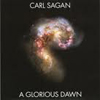 The beauty of this record is in how it makes the idea of space travel not only catchy but entertaining. I hope a lot of kids get a chance to hear it or watch it on youtube, because the lyrics, a collage of utterances made by Carl Sagan, Stephen Hawking, and other scientists, as run through an autotuner and placed atop a moving beat and driving melody are truly inspiring. This is popular science at its best.
The beauty of this record is in how it makes the idea of space travel not only catchy but entertaining. I hope a lot of kids get a chance to hear it or watch it on youtube, because the lyrics, a collage of utterances made by Carl Sagan, Stephen Hawking, and other scientists, as run through an autotuner and placed atop a moving beat and driving melody are truly inspiring. This is popular science at its best.
The summer wouldn't quite feel proper without weekly episodes of Do or DIY, the radio show hosted by Vicki Bennett of People Like Us on WFMU. Her voice, song selections, and mixes are now as much a part of the season as are morning mimosas on the Fourth of July, marinated mushrooms on my beat up grill, and smog alerts. The music Vicki plays on her show helps me keep a wistful attitude in an atmosphere of sizzling humidity and hot tempers. As the mistress of all things avant-retard, she also does a fine job in turning me on to all manner of captivating, kitschy, and corny songs.
Hence this 7" record. "Glorious Dawn" and the other songs, available as music videos for free watching and listening on symphonyofscience.com, became a steady, relentlessly addictive soundtrack for me a few weeks ago. When I saw that a 45 of one of the songs was available I had to have it. It is nice to have a physical artifact from the project, as opposed to it being purely online. The etching on the back makes it awesome: it is a reproduction of the diagram on the Golden Record placed in the Voyager spacecraft, the audio contents of which were selected by a committee chaired by Carl Sagan. In doing all this John Boswell, who is the man behind the project, has created a wonderful homage to his hero, even more so by naming the record after him.
As for the music: it shares little in common with the recent explorations of space music that I wrote about in my review of the Gultskra Artikler album Galaktika. It eschews the sometimes marginalizing approach more experimentally inclined musicians take in a favor of a populist path. Major chords, a buzzing bass line, and a sprinkling of piano and keyboard round out what is mostly a drum driven song. While there is plenty going on, none of it takes away or distracts from the lyrics which are the obvious focal point of "Glorious Dawn." When phrases like "how lucky we are to live in this time / the first moment in human history when we are in fact visiting other worlds" join in concert with the music I get excited about the many prospects science opens up for humanity. As far as I'm concerned, any music that gets people enthusiastic about science and exploration is a good thing.
samples:
Read More
- Administrator
- Albums and Singles
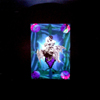 Following their excellent eponymous debut, this outré music supergroup reconvened after a brief break sans Elke Skelter, but with a pretty exciting new addition in her place (Jim O'Rourke). Given the pedigree of the players involved, it was no surprise at all that the resultant album was a strange and difficult one, but it managed to subvert my expectations anyway. Of course, having my expectations subverted when my expectation was "this will be a brilliant album!" is not entirely a good thing. Mimir clearly had admirable intentions and a formidable line-up for these sessions, but Mimyriad's success is much more evident as an artistic statement and an experiment.
Following their excellent eponymous debut, this outré music supergroup reconvened after a brief break sans Elke Skelter, but with a pretty exciting new addition in her place (Jim O'Rourke). Given the pedigree of the players involved, it was no surprise at all that the resultant album was a strange and difficult one, but it managed to subvert my expectations anyway. Of course, having my expectations subverted when my expectation was "this will be a brilliant album!" is not entirely a good thing. Mimir clearly had admirable intentions and a formidable line-up for these sessions, but Mimyriad's success is much more evident as an artistic statement and an experiment.
Aside from being a musical iconoclast and an extremely skilled producer, Christoph Heemann has also been blessed with an innate genius for complicating his own discography.The first version of Mimyriad , appearing in 1993, was one single 49-minute track.Six years later, Heemann decided to re-release it as a limited edition LP.Given the nature of the medium, it obviously could no longer remain a single uninterrupted track.Rather than just splitting it in half, however, Christoph re-edited and re-mixed the entire thing, splitting it into six separate pieces and removing about ten minutes of music that had earlier appeared on a compilation called Perpetual State of Oracular Dream as "December…Whatever."Heemann seems to have been quite pleased with his revision, as the most recent (2007) reissue sticks to the format of the 1999 record.I wish Mimir was a lucrative enough endeavor to warrant a comprehensive Bitches Brew-style box set of the Mimyriad sessions, as I suspect the raw material took some wildly different forms over the course of the three years it took to assemble the original version. That probably won't be happening anytime soon though.
Possible permanent state of flux aside, the most bizarre aspect of Mimyriad is that Mimir features two of the world's most compelling and creative guitarists, yet very little recognizable guitar playing (and much of it is fragmented or looped).That is a rather confounding and somewhat self-defeating move, and I am deeply curious about how it worked out that way.My suspicion is that Heemann himself gutted the album of as much melodic material as possible when he was assembling and mixing everyone's contributions.I'd be a fool to assume that I could fully understand Christoph's thought process, but Mimir's original stated intent was to create "textural music" and I think they deliberately took that as far as it could reasonably go here (which meant getting rid of anything that could distract from that).Despite being understated and spacey and generally sounding nothing at all like Heemann's former collaborator Masami Akita, Mimir actually make some very similar aesthetic decisions in rejecting melody, rhythm, and comfortable repetition.Merzbow, for his part, fills the resulting void with explosive, ear-melting raw power.Mimir, either gutsily or foolishly, opted to avoid filling the void at all here.
The other odd thing about this album is that it inhabits a no-man's land that is not quite ambient and not quite structured song.Instead, it unfolds in a somewhat narrative way like a very uneven hallucination or a film with very obvious set pieces, such as the extremely cool dissonant acoustic guitar interlude in part four, the warped and disorienting organ solo in part five, or the tense bongo, xylophone, and French horn (?) groove in part two.These "set pieces" are the only elements of Mimyriad that stick in my mind after the album is over, as the rest of the album merely feels like a series of transitions between that handful of "hooks."The transitions aren't boring or clumsy by any means (mostly Heemann's drones and swells and Edward Ka-Spel's trippy weirdness), but they aren't particularly memorable either.
For the most part, the atmosphere is somewhat dark, sometimes sublime, and occasionally nightmarish, but it is perversely bookended by a very sunny, jangly, krautrock-inspired jam.The closing appearance has some freaky backwards and warped guitars soloing over it to redeem it somewhat, but it is still very repetitive and relentlessly upbeat.Also, it feels like Heemann performed a bizarre feat of reverse alchemy here, taking everyone's ideas and twisting and splintering them during editing until they sound like an improvisation.Whether or not that was a good idea is entirely dependent upon how much any listener craves unpredictability (a commodity that Mimyriad delivers quite effectively).
It is hard to choose which of the two versions is the "definitive" Mimyriad, as the original single-track version makes more sense and some of the best parts were deleted in the remixing/re-editing.Despite that, the remixed version seems noticeably more coherent and less meandering: there is still a paucity of truly inspired moments, but the wait between them feels much more painless.On a purely intellectual level, I can appreciate and applaud Mimir's valiant attempt to push the sound into more abstract and epic territory with this album, but the more focused and immediately gratifying albums that sandwich it are far more likely to wind up in my CD player.
Samples:
Read More
- Administrator
- Albums and Singles
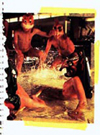 This 1991 release marked the beginning of the trilogy that many regard to be some of Andrew McKenzie's finest and most inspired work. Appropriately enough, its 2004 reissue by devoted super-fan Frans de Waard (Beequeen) marked the beginning of something still more notable: an ongoing campaign to track down and reissue as many hopelessly unavailable Hafler Trio albums as possible—with all omissions, glitches, and compromises eradicated and all financially suicidal packaging triumphantly intact.
This 1991 release marked the beginning of the trilogy that many regard to be some of Andrew McKenzie's finest and most inspired work. Appropriately enough, its 2004 reissue by devoted super-fan Frans de Waard (Beequeen) marked the beginning of something still more notable: an ongoing campaign to track down and reissue as many hopelessly unavailable Hafler Trio albums as possible—with all omissions, glitches, and compromises eradicated and all financially suicidal packaging triumphantly intact.
One of the qualities that makes Kill the King—a single 73-minute "ambient" piece—such a satisfying work is that McKenzie balances his characteristically aggressive contrarian and experimentalist impulses with massive, sustained, and subliminally buzzing drones and an occasional languorous pulse.Such concessions to listenability are quite uncommon in Hafler Trio's oeuvre, but I find them to be quite welcome when they appear.I am certainly a fan of H3O's more mischievous, bizarre, and abrasive tendencies, but having them presented within a context of semi-conventional structure and musicality definitely makes them more rewarding over multiple listens.I suspect Andrew would hate to hear that though.In fact, he seems to have had some misgivings about Kill the King's direction even while he was making it, as he managed to only narrowly avoid making a perfect ambient drone album through an artful act of late-song self-sabotage (a brief, but thoroughly cringe-inducing, dental drill interlude).
Atypically, Hafler Trio actually seems to have been almost an actual trio for this album, as McKenzie was allegedly joined by artist/short wave radio enthusiast John Duncan and composer Zbigniew Karkowski.I say "allegedly" because they are not credited anywhere on the reissue, though McKenzie cryptically mentions that he was assisted by "a disappeared" and"a never was." He also mentions that he composed one track using "a never can."More concretely, performance artist/sexologist Annie Sprinkle makes an actual credited appearance, lending her voice to be chopped and mangled into unrecognizability for a cathartic and disquieting mid-song sequence (a fascination that Andrew more fully explored in later years with the help of Blixa Bargeld, David Tibet, and Jónsi).Aside from Sprinkle and a distorted recording of a different woman speaking at the album's onset, however, it is impossible to tell where any of the sounds may have originated, as they are all distilled into either a swirling, quivering shimmer or an ominous rumble.
McKenzie has long been quite hostile toward digital release (and sharing) of his music and it is easy to see why.Kill the King (as well as many other H3O releases) is more of a bizarre multimedia experience than an album—to miss the art and text is to miss something quite integral to the H3O vision.In fact, the accompanying booklet is a masterpiece in its own right, both as a feat of graphic design and as an impenetrable enigma.I am almost completely certain that the whimsically disquieting pictures, pages of brief evocative text, six seemingly extraneous song titles, and random (?) words in a silver font are mere red herrings that have nothing to do with the music, but I still have a sliver of doubt.And if they are, I am forced to wonder if McKenzie threw them in to be deliberately annoying and misleading, or if there is something deeply witty or profound being hinted at.Regardless of their original intent, all of those little touches combine to make it clear that this object is coming to me from a rather curious and alien place and bears little resemblance at all to the comparatively homogenous commodities released by "serious" musicians that want to be liked.In recent years, however, McKenzie has taken his passion for unique packaging to the furthest possible extreme, forgoing CDs entirely in favor of offering one month of his creative life to create an individualized, one-of-a-kind "art object" for anyone who can finance it.
An amusing (and probably intentional) irony that I noticed when listening to Kill the King is that, if I didn't know better, it would be totally plausible for a brilliant psycho-acoustic researcher to have been involved in the making of this album (like fictitious founding member Dr. Edward Moolenbeck).Or maybe the irony is that Andrew himself is something of a brilliant psycho-acoustic researcher.Superficially, this is drone music, but the attention to minor detail and pure sound is on a level that few have the ability or willingness to attempt.It's almost like this album could have emerged from an aborted military experiment to create sound waves that are so vibrant and psychotropic on a microcosmic level that hapless enemy combatants would be unable to do anything but listen intently.This is, quite simply, an utterly absorbing and unpredictable release from one of the most twisted and calculating minds in modern music.
Samples:
 
 
Read More
- Administrator
- Albums and Singles
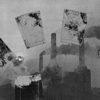 Considering the album’s title suggests a bleak monochromatic soundscape, Colin Potter and Phil Mouldycliff quickly confounded my limited expectations with their vivid field recordings and processed sounds. They take us by the hand and lead us on a tour of a sleepy village found somewhere between the Mediterranean coast and the edge of consciousness. Trembling and sonorous, the music the pair generate over the course of the album is rich with delicate textures and hidden beauty.
Considering the album’s title suggests a bleak monochromatic soundscape, Colin Potter and Phil Mouldycliff quickly confounded my limited expectations with their vivid field recordings and processed sounds. They take us by the hand and lead us on a tour of a sleepy village found somewhere between the Mediterranean coast and the edge of consciousness. Trembling and sonorous, the music the pair generate over the course of the album is rich with delicate textures and hidden beauty.
The opening section brings to mind Luc Ferrari’s Presque Rien but Potter and Mouldycliff wrap their recordings in a kaleidoscopic haze. Babbling conversations are heard through a psychedelic filter, the words becoming indistinct with only a glimmer of recognition remaining. With crystal clarity, church bells ring over the hubbub to reinforce my mental image of a small, sunny village hidden between green hills. Even later in the album when the detail of these field recordings fades to a rough outline, the genial ambience of the original sounds is maintained throughout Grey Skies on Asphalt.
As the album progresses, the source materials become more obscured by Potter and Mouldycliff’s manipulations. The middle section of the album leaves behind identifiable sounds almost completely: what sounds like radio interference could be anything. Even when some remnant of familiarity is retained, the sounds are being heard from an angle that is a novelty. Murky voices become giant and alien (although strangely unthreatening) and warm humming noises are presented along with shimmering tones to maintain the character of that sunny day in a country community. The church bells may remain ever present but despite their distinct sound, they begin to collapse in on themselves, their essence transmutated into new forms by the duo.
Each time I listen to Grey Skies on Asphalt, I cannot help but sink into a relaxed reverie. The album’s capacity for inducing Technicolor daydreams is immense; both Potter and Mouldycliff are well able to create mentally stimulating sound works on their own but this collaborative effort has intensified their talents greatly. When the album finally comes around full circle to the untreated field recordings, it is only then that I realize how far Potter and Mouldycliff have brought me on their journey.
samples:
 
Read More
- Administrator
- Albums and Singles
 For Sub Rosa's second blues compilation, they swing their gaze from relatively unknown blueswomen to unsung bluesmen. Crackling, distorted recordings betray the battered, forgotten nature of these individuals but through the murk of time come songs and voices that sound utterly alive and unblemished by almost a century of pillaging at the church of the blues. Although varying in quality (both in terms of the songs and the recordings themselves), I'm Going Where the Water Drinks Like Wine is a fine presentation of undeservedly obscure musicians long lost in the dusty recesses of personal record collections and thrift stores.
For Sub Rosa's second blues compilation, they swing their gaze from relatively unknown blueswomen to unsung bluesmen. Crackling, distorted recordings betray the battered, forgotten nature of these individuals but through the murk of time come songs and voices that sound utterly alive and unblemished by almost a century of pillaging at the church of the blues. Although varying in quality (both in terms of the songs and the recordings themselves), I'm Going Where the Water Drinks Like Wine is a fine presentation of undeservedly obscure musicians long lost in the dusty recesses of personal record collections and thrift stores.
The album begins at the most logical point of all for a recorded history of the blues, the first known recording of that quintessential blues technique: the slide guitar. In 1923, Sylvester Weaver brought his bottleneck style (or knife blade style depending on his mood) to the then blossoming world of recorded music. The results can be heard here on "Guitar Blues;" the fundamental cornerstone of the blues just about audible under the gravelly surface noise of the ancient 78 record. It is a simple, beautiful and unassuming piece of music with buckets more feeling than the decades of clichéd slide guitar that has followed.
Clichés in general are put to the sword throughout the album, even lines like "my mama’s dead, my daddy too/that’s the reason why I’ve got these weeping, moaning blues" sound shockingly genuine to this day. As someone who generally finds the blues to be a sometimes interesting musical relic rather than a moving artistic experience, I'm Going Where the Water Drinks Like Wine pushes a lot of the right buttons for me. Like a lot of early blues recordings, the sense that this music was still a living, breathing and evolving form of playing as opposed to a bunch of similar scales trotted out by overpaid rock musicians is strong here.
The sweet fiddle of Andrew Baxter, accompanied by his son Jim on guitar, on "K.C. Railroad Blues" shows the co- option of contemporary folk and country playing into the early blues, a natural and perfect marriage of styles. Willard Ramblin' Thomas' "No Job Blues" strikes a particular chord, its encapsulation of the harshness of the Great Depression finding some parallels in the spiralling unemployment and financial turmoil of today (although luckily things have not hit quite as hard now as in the twenties). His deft guitar playing sounds deceptively simple; notes spiral from his fingers like water from a sprinkler.
Despite such a massive trawl through early blues recordings by the likes of Alan Lomax and Harry Smith throughout the 20th century, I'm Going Where the Water Drinks Like Wine is evidence that there is still much detective work to be done. The scant biographical details (even some of the artists’ names are up for debate) included in the sleeve notes paint these recordings as lost snatches in time by men that remain almost totally anonymous in the public eye. That is part of the appeal of this album, these songs are being sung by voices on which we can concoct our own stories; the trappings of myth and history not clouding the music like the songs of infamous bluesmen like Robert Johnson or Leadbelly.
samples:
- Andrew Baxter, "K.C. Railroad Blues"
- Arthur Petties, "Down South Blues"
- Noah Lewis, "Devil in the Woodpile"
 
Read More
- Administrator
- Albums and Singles
MAINS DE GIVRE is a violin-centered soundscaping project involving self-taught experimentalist Eric Quach and classically trained musician Émilie Livernois-Desroches, both of whom call Montreal home. Quach is widely known for the experimental ambient work he's produced under his thisquietarmy alias and also is the founder of the instrumental-shoegazer band Destroyalldreamers. Livernois-Desroches has played violin since she was seven years old and been teaching since 2003. She has been a part of various chamber music and symphonic orchestras, and performs with a wide variety of bands in styles ranging from pop to medieval to metal. While her previous best-known project was the melodic folk-black metal band Blackguard (formerly known as Profugus Mortis), Mains de Givre is her most experimental project to date.
Quach and Livernois-Desroches first crossed paths in 2003 while playing with their respective bands Destroyalldreamers and Sugarshack as part of the emerging post-rock scene in Montreal. Following each other's musical achievements over the years, their mutual respect for each other grew until they found themselves six years later embarking on a studio collaboration initially intended to be part of a thisquietarmy release. As their personal and musical chemistry grew, their newfound closeness turned the collaboration into an official long-term project they christened Mains de Givre (frost hands) after a nickname that had been given to Émilie (émilie-aux-mains-de-givre) by her bandmates.
Mains de Givre's debut album, Esther Marie, originates from material recorded at the duo's first jam session in the spring of 2009. The recording opens with the very first notes the two played together, notes that evoke an eerie sadness that permeates the album and characterizes the mood of their collaboration. With the violin as the lead instrument, Quach's guitar playing is restrained yet also tense, as he generates dark, slowly evolving drone atmospheres alongside subtle, looped-based patterns that swirl within the lower end of the sound spectrum.
In terms of media coverage, the recording has received unanimous praise from many different quarters: it was given the number three slot in Fluid Radio's June Top 10; characterized as "amazing ambient soundscapes" and given a grade of 8.5/10 by The Montreal Mirror; described as a "stunning collection of deeply atmospheric and dark experimental compositions" and "a truly magnificent record, which should be missed under no pretext," and awarded a 5/5 rating by The Milk Factory; and featured on the playlists of radio stations WNYC (New York), CKUT (Montreal), and CHYZ (Montreal).
For more info and purchasing details, go here: http://www.textura.org/pages/archives.htm
Read More
- Administrator
- Albums and Singles
Now available from BRAVEMYSTERIES.COM
CQBL004 | The Second Family Band | Veiled Gallery | c42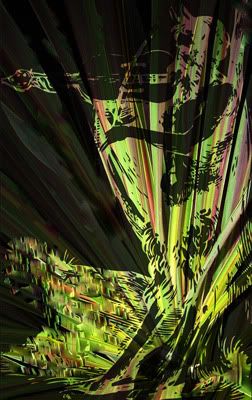
[Limited edition 20 Green on Lime | 80 Green on Black]
Humming and wheezing through 40+ minutes of electro-acoustic tension and release, with the usual mood swings from good vibes to hysteria, the Second Family Band is the still-raging avatar of our lonely local folkspirit. Second Family Band folks are everyone from the recent University of Wisconsin dropouts to aging remnants of the anarcho/folkish/mage/squatter tradition of Madison, featuring members of Davenport Family, Pan to Scratch, Zodiac Mountain, Drunjus, Hintergedanken, Burial Hex, Jex Thoth, Zola Jesus, Kinit Her, Crystal Dragon, and many other local units. This cassette contains six choice excerpts from two sessions given near the end of summer, 2009. The first session was a huge family gathering at the newly installed Harvest Abbey in Madison. The second session was a beautiful performance by a trio of elders within St Mary's of the Oaks, a 154 year-old Marian altar built on a hilltop in the forest around Indian Lake. If you have heard Second Family before, than you know a little bit of what to expect: loads of percussion, singing, plucking, pounding, tapping, dropping, alien choirs, bass grooves, naked ladies, strange fidelities, chanting, praying, drinking, strumming, smoking, ringing, clapping, bowing, pulsing, losing, forgetting, and finding everything in every type of mood from the sinister to the blissful. Yet, one local cynic described the music on this tape as sounding "too good for Second Family Band". Whatever the case may be, Brave Mysteries is proud to release this document of a momentary glance into the native spirit and biodynamic soundscape of central Wisconsin, in hopes to keep these gentle old family flames burning for yet another season.
All cassettes are professionally duplicated and imprinted on high-bias chrome tapes and are delivered individually shrink-wrapped. Colored tapes are shipped first come first serve only.
PPD $7-USA | $8-CAN | $10-WORLD
PayPal bravemysteries[at]gmail.com
Read More
- Administrator
- Albums and Singles
Now available from BRAVEMYSTERIES.COM
CQBL002 | Kinit Her | Divine Names | c30 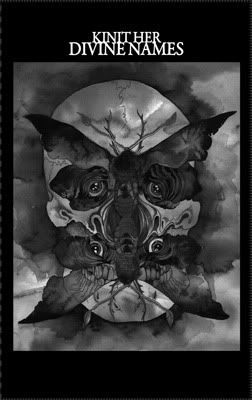
[Limited edition 20 Silver on Blue | 80 Silver on Black]
New full length album from our beloved Janus-headed ur-folk brethren of thee Midwest, Kinit Her have been releasing dense and gorgeous music for the last three years and these new compositions have the most developed, deep and intimate sounds of any Kinit Her releases. Founded as a trio in 2007, one of their founding members has recently retired from music to enjoy family life out in the country, sadly leaving only two close brothers still huddled around the cauldron. In the absence of their musical kin, Kinit Her journeys on, gathering what they find along the path, filling their hearts and sounds with an ever-deepening sorrow gained from their search for real meaning through the tainted veils of the modern world, a sorrow diluted only by the dim glimmering of hope offered by occult insights into what lies behind those veils. The music presented here includes an epic working that covers all of side A, progressing from a ritual howling at the edge of Ain Soph to a pensive woodland march, winding it's way to devastation and madness. Side B follows with some their most unique yet accessible songcraft to date, a stunning set of new songs, showing the careful influence of Neoclassical and Early musics. Sounding organic tone-mantras from shofar horns, bending sweetened notes on beaten twelve-string guitars, intoning a harmonized enumeration of spells and dreams, backed by weeping string and brass arrangements with lush acoustic ephemera twinkling on the peripherals of everything, twisting arcane runes into the cyber sigils of tomorrow, with their smoldering mysticism filling the spaces in between each sound, this soft duo have become hard, turning the world upside down and following the lessons of modernity to find their birthrights in the spirit of the god-fearing troubadours of old.
All cassettes are professionally duplicated and imprinted on high-bias chrome tapes and are delivered individually shrink-wrapped. Colored tapes are shipped first come first serve only.
PPD $7-USA | $8-CAN | $10-WORLD
PayPal bravemysteries[at]gmail.com
Read More